Chassis Refurb Options
Discussion
ChimpOnGas said:
TVRMs said:
Dave
It will be interesting to see how your coating stands up as it appears the coating is not intended for brush application?
That would be a worry to me, but for the fact you're talking out the back of your head, I don't know where you're getting your information from but quite simply you are wrong.It will be interesting to see how your coating stands up as it appears the coating is not intended for brush application?
I'm not sure what point you're trying to make but unsupported misinformation seems like competitive point scoring to me, sadly your lack of research has left you exposed to embarrassment but I'll let the paint manufacturer themselves take care of that....
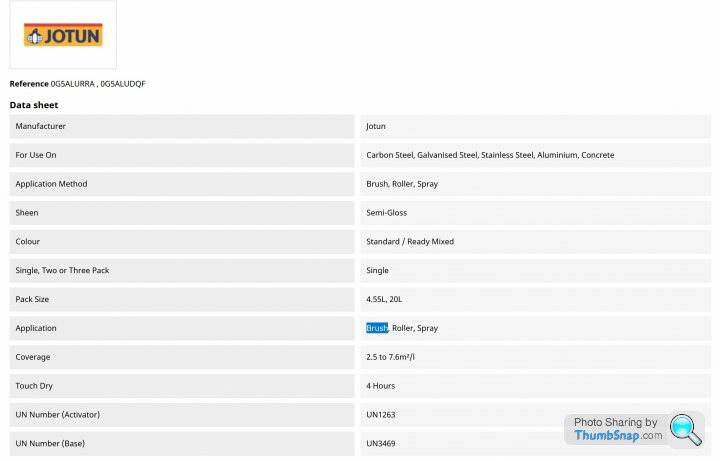
According to Jotun, and one assumes they should know as they make the paint, their Jotamastic 90 product is designed to be applied from anything between 100 to 300 microns in a single coat, as clearly shown above the application can be by brush, roller or spray equipment.
To be clear 100 to 300 microns is a huge range of film thickness, a paint with 60% volume solids applied by brush will typically have a wet thickness of 100 microns, admittedly Jotamastic 90 is a little thicker at 80% solids by volume so you end up with a wet thickness of 133 microns, but quite clearly this is still massively within the manufacturer's own spec being well below the 300 micron maximum film thickness they quote.
Finally if Jotamastic really wasn't meant to be applied by brush, why on earth would they include an image of a guy brush painting the stuff in their Jotamastic catalogue

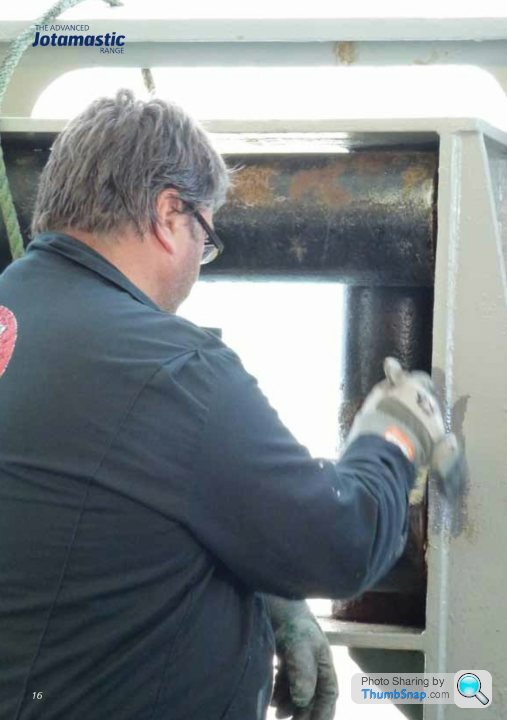
I got my information from their very detailed technical info guide which mentions brush application for stripe coating. I was inaccurate in suggesting it doesn't mention brushes anywhere.
https://www.jotun.com/Datasheets/Download?url=%2fT...16560__Jotamastic+90__EukGB.pdf
I was not trying to score points I was trying to add some balance to a thread that started with some poor advice (IMO) from yourself.
You were obviously happy with your coating choice or you wouldn't have gone ahead with it. Time will tell how it fairs with the environment you subject it too.
So, do I feel embarrassed or exposed, not at all.
I live an a world where I accept people make choices sometimes get it wrong, if I did in this case I apologise, like I say, I read their very detailed application guide.
Strikes me you live in a slightly different world - enjoy, but please try to be a little more civil.

Edited by anonymous-user on Friday 19th June 08:13
Are these Epoxy mastic paints not brush applied as in working in the field where spraying would be difficult?
There is plenty of evidence it’s applied this way in industry!
I’ve used Rustbusters epoxy mastic paint on my chassis which can also be painted by hand?
Mine has been sprayed on but if your working conditions are in line with paint manufactures guidance brush painting is quite acceptable according to the few things I read re brush applying. At the end of the day any coating will become brittle or chip off from heavy impacts or ramp legs scratching them for instance.
Let’s see shall we,,,,,,,,,,
If my wishbones have peeled back paint and flakes off by hand once breached as my brand new powder coated ones displayed after only 3 years driving in all conditions including winter then it’s no better than powdercoat.
Watch this space. If you strike the edges of things like wishbones ( errr by brush ) before you spray as recommended by the paint manufacturer then apply 2 coats of sprayed on epoxy mastic paint I’d hazard a guess the bond to steel is way more effective once it hardens off than any powdercoat will ever be.
What are people actually trying to say here? Beats me
The simple evidence is as almost every chassis displays Powdercoat damage or peel back from edges where it has little surface area to grip. Striking edges by hand before spraying locks in these edges so we will just have to wait and see. If brand new Powdercoated wishbones were rusty as hell within 3 years I’ll frankly be dismayed if my recently blasted and painted bones do the same thing. I’m confident they will be fine
There is plenty of evidence it’s applied this way in industry!
I’ve used Rustbusters epoxy mastic paint on my chassis which can also be painted by hand?
Mine has been sprayed on but if your working conditions are in line with paint manufactures guidance brush painting is quite acceptable according to the few things I read re brush applying. At the end of the day any coating will become brittle or chip off from heavy impacts or ramp legs scratching them for instance.
Let’s see shall we,,,,,,,,,,
If my wishbones have peeled back paint and flakes off by hand once breached as my brand new powder coated ones displayed after only 3 years driving in all conditions including winter then it’s no better than powdercoat.
Watch this space. If you strike the edges of things like wishbones ( errr by brush ) before you spray as recommended by the paint manufacturer then apply 2 coats of sprayed on epoxy mastic paint I’d hazard a guess the bond to steel is way more effective once it hardens off than any powdercoat will ever be.
What are people actually trying to say here? Beats me
The simple evidence is as almost every chassis displays Powdercoat damage or peel back from edges where it has little surface area to grip. Striking edges by hand before spraying locks in these edges so we will just have to wait and see. If brand new Powdercoated wishbones were rusty as hell within 3 years I’ll frankly be dismayed if my recently blasted and painted bones do the same thing. I’m confident they will be fine

Edited by Classic Chim on Friday 19th June 08:17
Classic Chim said:
Are these Epoxy mastic paints not brush applied as in working in the field where spraying would be difficult?
There is plenty of evidence it’s applied this way in industry!
I’ve used Rustbusters epoxy mastic paint on my chassis which can also be painted by hand?
Mine has been sprayed on but if your working conditions are in line with paint manufactures guidance brush painting is quite acceptable according to the few things I read re brush applying. At the end of the day any coating will become brittle or chip off from heavy impacts or ramp legs scratching them for instance.
Let’s see shall we,,,,,,,,,,
If my wishbones have peeled back paint and flakes off by hand once breached as my brand new powder coated ones displayed after only 3 years driving in all conditions including winter then it’s no better than powdercoat.
Watch this space. If you strike the edges of things like wishbones ( errr by brush ) before you spray as recommended by the paint manufacturer then apply 2 coats of sprayed on epoxy mastic paint I’d hazard a guess the bond to steel is way more effective once it hardens off than any powdercoat will ever be.
What are people actually trying to say here? Beats me
Jotun is brush stripe then sprayed. Don't know if that's the norm.There is plenty of evidence it’s applied this way in industry!
I’ve used Rustbusters epoxy mastic paint on my chassis which can also be painted by hand?
Mine has been sprayed on but if your working conditions are in line with paint manufactures guidance brush painting is quite acceptable according to the few things I read re brush applying. At the end of the day any coating will become brittle or chip off from heavy impacts or ramp legs scratching them for instance.
Let’s see shall we,,,,,,,,,,
If my wishbones have peeled back paint and flakes off by hand once breached as my brand new powder coated ones displayed after only 3 years driving in all conditions including winter then it’s no better than powdercoat.
Watch this space. If you strike the edges of things like wishbones ( errr by brush ) before you spray as recommended by the paint manufacturer then apply 2 coats of sprayed on epoxy mastic paint I’d hazard a guess the bond to steel is way more effective once it hardens off than any powdercoat will ever be.
What are people actually trying to say here? Beats me
I also don't know the quality of powder coat your wish bones received so I won't comment for fear of having an opinion...
All I will suggest is that it's hard to compare coating systems when you don't know if the coatings being compared are applied to manufacturers standards or not.
The likes of Jotun coatings being discussed are designed for very harsh environments where recoating is generally very expensive (Offshore environment) and therefore the preparation and controls they have in their technical data are to ensure the coating will perform at it's best.
For a chassis on a car used through the UK winters it should survive well, completely brush coated or to the manufacturers procedure that is trying to avoid that expensive recoat. Interesting that many coatings systems for these harsh environments now start with a base coat of TSA on carbon steel.
Note, it's TSA not TBA

Edited by anonymous-user on Friday 19th June 08:40

To solve the confusion and to understand why Jotun have used the above image in their Jotamastic catalogue, I reached out to their technical department who told me the image was Sven demonstrating their new airless spray gun.
Apparently it works like this:
1. First dip the gun into the mixed Jotamastic
2. Now heres the clever bit,,, Alow a few seconds for the revolutionary spray gun fibers to absorb the paint
3. Transfer the absorbed paint to the surface you're painting using an even up and down motion
When I asked Jotun what they were calling this revolutionary system they were reluctant to tell me, I pressed further and eventually was told...
"It's an effin brush you retard, can't you see that from the photo?"
Seriously folks, if anyone has read the misinformation of others and is now concerned if Jotamastic can be applied by brush I strongly recommend speaking with the technical department at Jotun who are very helpful, they will confirm the whole Jotamastic range is designed to offer flexibility in terms of the application method, and that means brush, roller, and spray.
When a marine maintenance engineer is on site completing localised repairs to a steel structure or vessel he needs a forgiving paint system that can be applied in harsh environments by brush, and of course Jotun designed their Jotamastic product for this very market which is why....
1. Jotamastic is designed to be used where perfect surface preparation and de-rusting is not always possible or desired
2. Jotamastic is formulated to adhere extremely well to all types of surface coatings making over-coating possible even if its unclear exactly what paint type was used previously
3. You most definitely can apply the entire Jotamastic range by brush which is why they show a man brush painting the product in the Jotamastic catalogue and they provide the following chart.....

The Jotamastic 90 Aluminum used on my chassis is basically the latest upgraded formula of the 87 Aluminum shown above, the paints with aluminum added are their best performers in the range of high performance Jotamastic paints which is why they recommend their use below the water line or where constantly exposed to saline splash, more on why the aluminum element is added and how it works here....
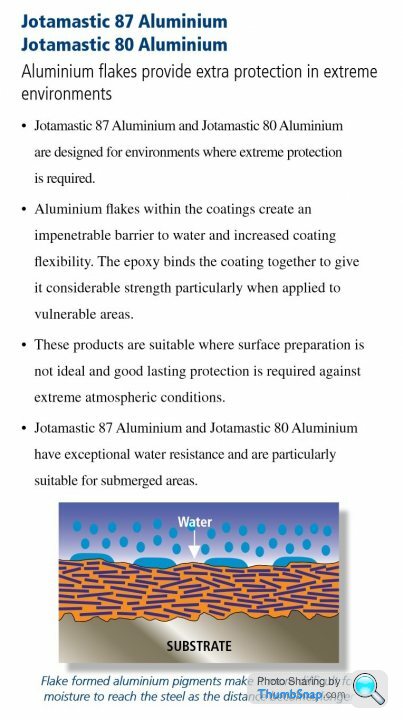
The aluminium also acts as a form of cathodic protection, zinc rich paints work the same way because both zinc and aluminum sit at other end of the periodic table to mild steel. The aluminum in the paint acts as the sacrificial anode ie the metal that is the most negative charged and less noble, the cathode is the mild steel that has the most positive charge (more noble) so will be the cathodically protected element.
Jotun do not recommend painting an entire vessel hull in Jotamastic by brush, but lets be honest you'd have to be a masochist to do that, other than this brush painting Jotamastic is fine, indeed its precisely how its designed to be used. The Jotun literature explains the high volume solids (82–87%) allows application up to 300 microns dry film thickness in a single coat, on wet application the range is actually 125 to 375 microns.
Being frank if 375 microns is considered acceptable you could apply by trowel and it'll be fine so brush painting the stuff really is a non-issue as even the clumsiest painter will be hard pressed to go over 200 microns, to be honest you can use Jotamastic as filler as it'll flow well into very deep cracks and bond like chit to a blanket!
Jotun's Jotamastic literature goes on to say,.....
"With application by airless spray, brush or roller even the most difficult to reach areas can be protected fast – no blast cleaning is necessary. Shorter application time = less cost, and no compromise in protection".
Of course the real benefit of these high tech wet paint systems over powder coat is their ability to properly bond to the substrate, as demonstrated by this illustration, and again taken directly from the Jotamastic literature.
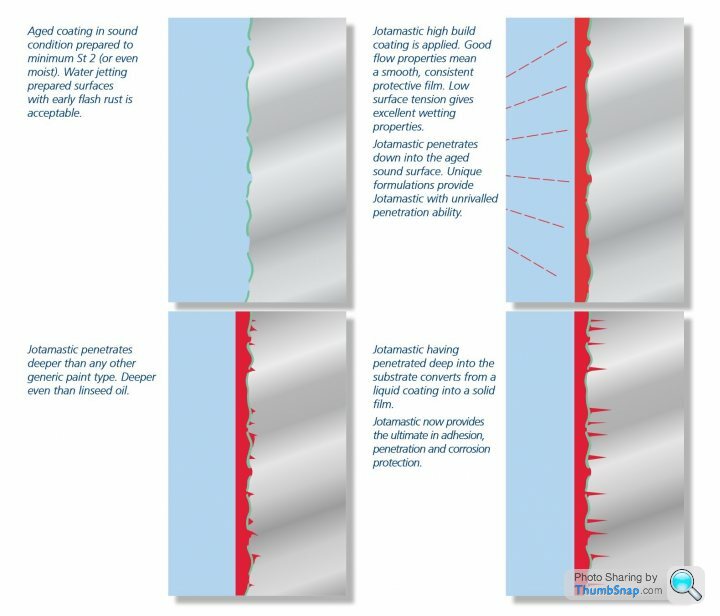
Powder coat simply can't and won't have the same bond to the substrate, before baking the powder only sticks to the work electrostatically and once baked it forms what can best be described as a wrap, rather than a finish that genuinely chemically locks itself on a molecular level to the substrate as Jotamastic epoxy mastic will.
These are the facts!
Edited by ChimpOnGas on Friday 19th June 10:51
Shed TVR said:
No need to argue gents, I'm sure there are plenty of legitimate reasons someone might choose either coating method.
I appreciate all the great information provided in this thread, thanks all!
I think we've kissed and made up now I appreciate all the great information provided in this thread, thanks all!

Its good to have a bit of balanced and evidenced debate and in this case there's no real right and wrong, but hopefully enough factual information for you and others to make a rational decision?
Wishing you all the best with your chassis restoration, however you approach it you'll be giving 1990's British icon a new lease of life which should be commended

Dave

ChimpOnGas said:
Shed TVR said:
No need to argue gents, I'm sure there are plenty of legitimate reasons someone might choose either coating method.
I appreciate all the great information provided in this thread, thanks all!
I think we've kissed and made up now :I appreciate all the great information provided in this thread, thanks all!
Dave


Shed TVR said:
Haha good to hear chaps. Quick question regarding the fuel lines which I couldn't find from searching - I have part copper line and part flexible on my car. Is it OK to replace this totally with flexible lines?
Thanks
It's done that way for a reason, it's the same with brake lines, you always use solid lines where you can as they are stronger, safer, and longer lasting. Thanks
Flexible hoses are only used where movement is expected, for fuel lines that means the transition from solid to flexi is at the engine, for brake hoses its at each wheel due to suspension articulation.
You wouldn't plumb your entire brake system with flexible hose, neither should you plumb the tank to fuel rail and back to the tank in flexible fuel hose either.
With flexible hoses, less is most definitely more

Just to add the final coals to the fire.
Paint or powder coat is tested in a factory.
Some poor bod has to write instructions for the controlled application of these coatings.
Test, test & test again. Leave in salt water for a year. What a pity its a static tank.
Now heres the thing none of these coatings are fool proof & fools are ingenious.
So any coating is only as good as the person preparing the metal for its base coat & applying the top coat.
So if you know a good tradesman then use with confidence.
I have powder coated bike frames, that works well because the tubes are round with no sharp edges.
For the car i prefer paint because its easier to repair & touch up with sharp edges etc.
Your choice Gents & i will not try & ram an opinion down any ones throat.
Paint or powder coat is tested in a factory.
Some poor bod has to write instructions for the controlled application of these coatings.
Test, test & test again. Leave in salt water for a year. What a pity its a static tank.
Now heres the thing none of these coatings are fool proof & fools are ingenious.
So any coating is only as good as the person preparing the metal for its base coat & applying the top coat.
So if you know a good tradesman then use with confidence.
I have powder coated bike frames, that works well because the tubes are round with no sharp edges.
For the car i prefer paint because its easier to repair & touch up with sharp edges etc.
Your choice Gents & i will not try & ram an opinion down any ones throat.
ChimpOnGas said:
It's done that way for a reason, it's the same with brake lines, you always use solid lines where you can as they are stronger, safer, and longer lasting.
Flexible hoses are only used where movement is expected, for fuel lines that means the transition from solid to flexi is at the engine, for brake hoses its at each wheel due to suspension articulation.
You wouldn't plumb your entire brake system with flexible hose, neither should you plumb the tank to fuel rail and back to the tank in flexible fuel hose either.
With flexible hoses, less is most definitely more
Thanks Dave, good explanation and makes sense to me. Flexible hoses are only used where movement is expected, for fuel lines that means the transition from solid to flexi is at the engine, for brake hoses its at each wheel due to suspension articulation.
You wouldn't plumb your entire brake system with flexible hose, neither should you plumb the tank to fuel rail and back to the tank in flexible fuel hose either.
With flexible hoses, less is most definitely more


I’ve pulled my chassis out and dropped it off in Sheffield @ RT Racing (now owned by Arian at Central TVR) for a full blasting and new outriggers and considering Zinc & Thermoplastic coating as I’ve ready everyone's opinions on powder coating.
Has anyone had their chassis Thermoplastic coated and does it melt near the exhaust manifolds or the rest of the exhaust.
Alternatively I may consider POR15 as used it 15 years ago and still have no signs of rust returning.
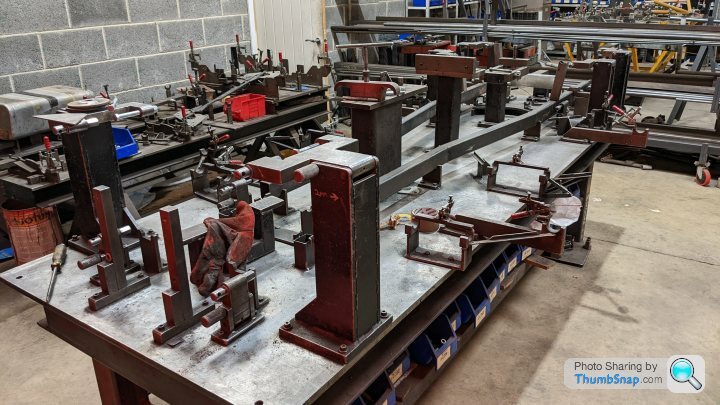
I’d think it’s a reasonable move to use heat protective tape on the top rails.
An exhaust blow and just the proximity of the manifolds suggests a fading/ darkening of the coated area so as tape can be removed and replaced as time goes by hopefully keeping tubes underneath better protected in any case.
I often think bespoke alloy shielding suspended off the chassis would be more effective but space is at a premium down there.
If Tvr chassis are known to twist a bit then the heat on the top tubes must be a weak point so protection seems prudent.
An exhaust blow and just the proximity of the manifolds suggests a fading/ darkening of the coated area so as tape can be removed and replaced as time goes by hopefully keeping tubes underneath better protected in any case.
I often think bespoke alloy shielding suspended off the chassis would be more effective but space is at a premium down there.
If Tvr chassis are known to twist a bit then the heat on the top tubes must be a weak point so protection seems prudent.
Edited by Classic Chim on Tuesday 8th November 08:34
Is that a home made jig or is this a TVR workshop tool?
I’ve rarely seen pics of a TVR chassis in its original jig.
That looks like a glorious place to work.
Looking forward to seeing this.
I see you have sleeved your outriggers in the past. Extra strength. I like that or was that an early rigger replacement technique.
Looks good either way.
Sorry I can’t answer your question but the Por15 you applied appears to have coped very well.
Looking at my 20 year old rotten riggers I concluded it was just as rotton 10 years previously and when I bought the car suggesting late TVR powder coating was failing badly within 5-10 years after sale date.
Does that say anything about powdercoating or simply how TVR applied it back then or maybe how and when my car was used.
I think the epoxy mastic paint applied on my chassis is more durable than PC. it’s easier to touch up at a later date and keep chassis water tight.
I’ve rarely seen pics of a TVR chassis in its original jig.
That looks like a glorious place to work.
Looking forward to seeing this.
I see you have sleeved your outriggers in the past. Extra strength. I like that or was that an early rigger replacement technique.
Looks good either way.
Sorry I can’t answer your question but the Por15 you applied appears to have coped very well.
Looking at my 20 year old rotten riggers I concluded it was just as rotton 10 years previously and when I bought the car suggesting late TVR powder coating was failing badly within 5-10 years after sale date.
Does that say anything about powdercoating or simply how TVR applied it back then or maybe how and when my car was used.
I think the epoxy mastic paint applied on my chassis is more durable than PC. it’s easier to touch up at a later date and keep chassis water tight.
Gassing Station | Chimaera | Top of Page | What's New | My Stuff











